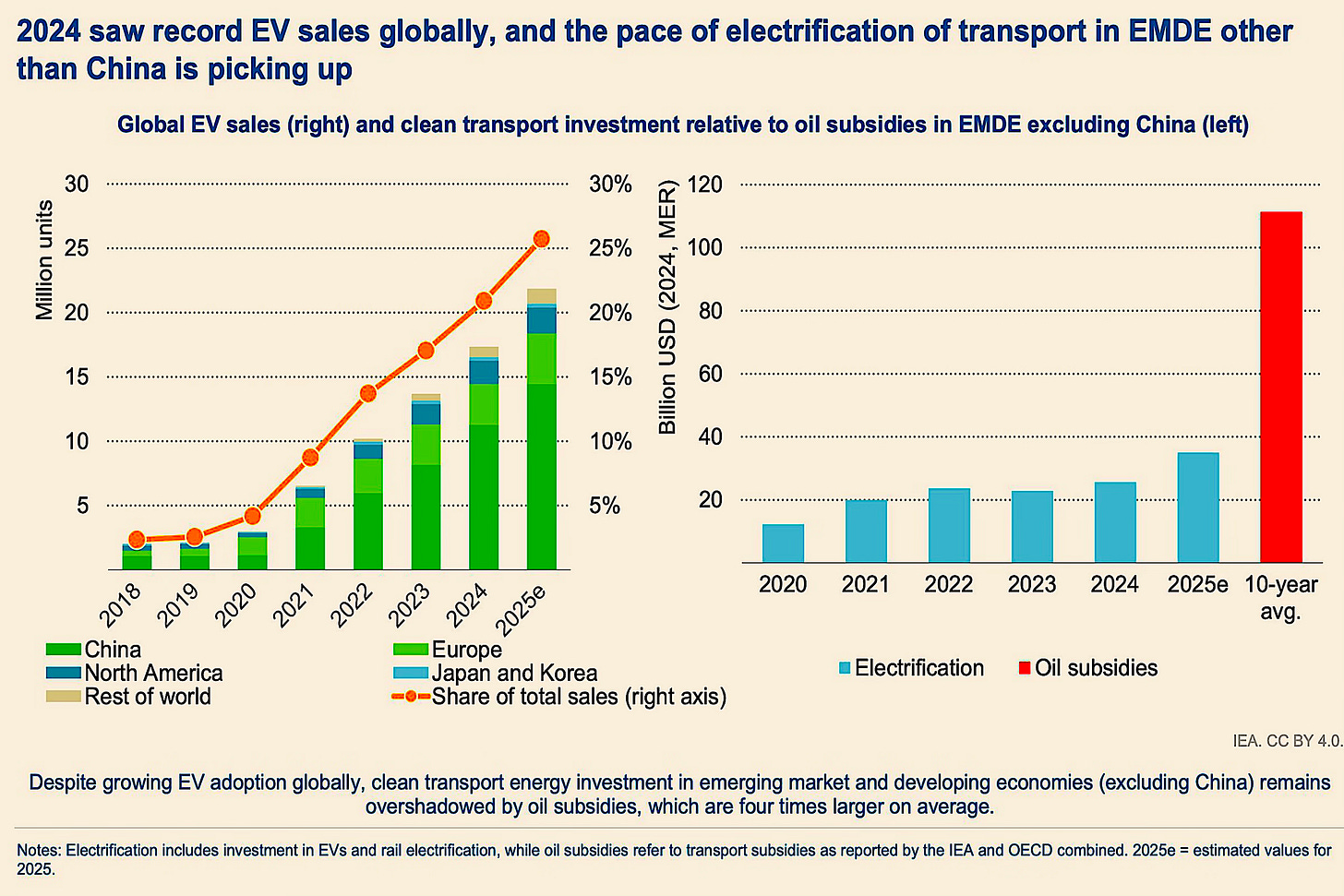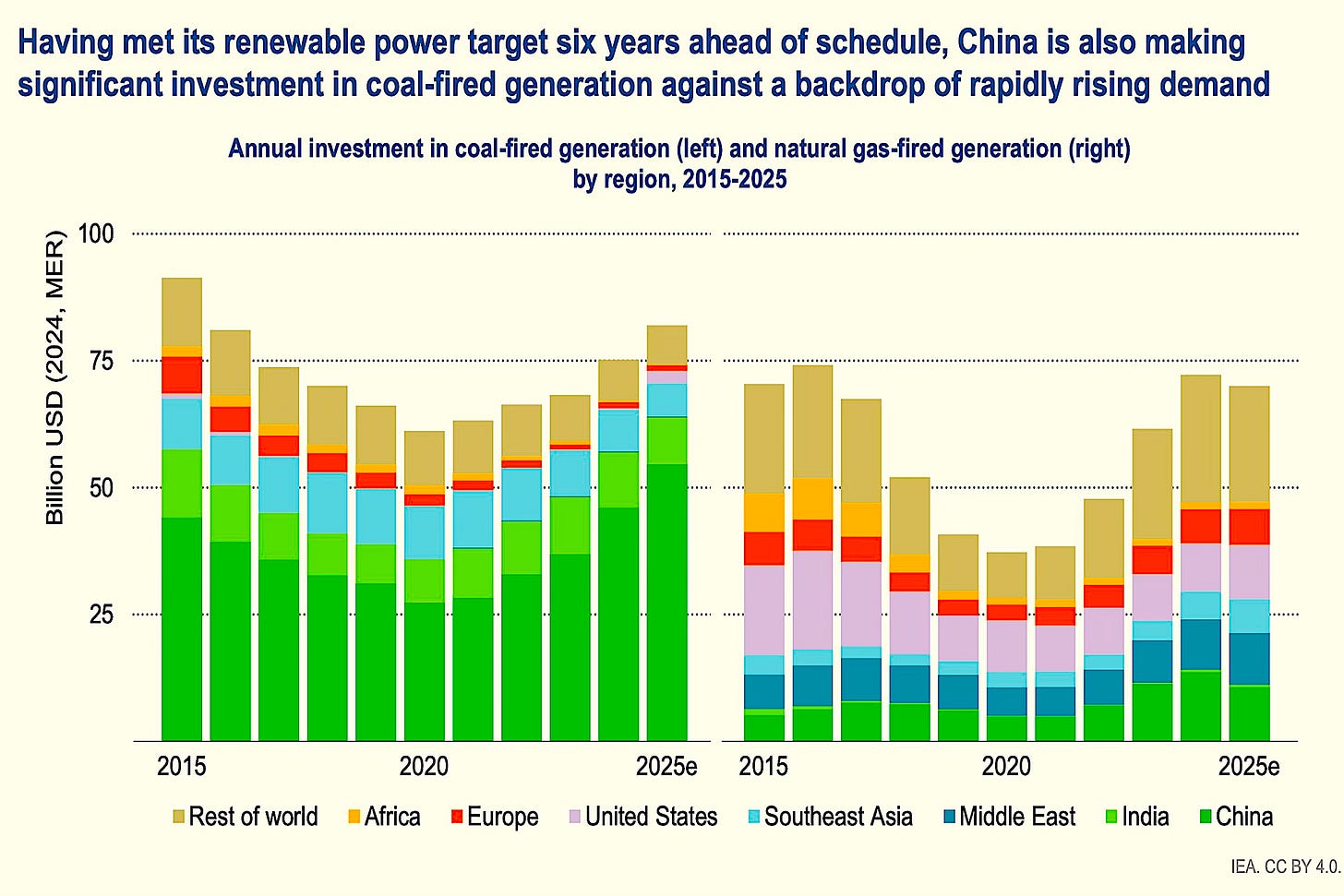International Energy Agency Spins Data to Suggest the Green Energy Transition Is Still A Thing. It's Time to Get Out.
The International Energy Agency (IEA), according to Perplexity, receives 14% of its revenue from U.S. taxpayers. Every bit of it is wasted, if its “World Energy Investment 2025” report is any indication. It is pure political spin intended to defend a green energy transition that is crumbling faster than week-old cornbread. Every page drips with excuses and rationalizations to explain away why the transition isn’t taking hold as projected.
One of the best examples of this from the report:
The word “subsidies” appears but 22 times in the entire 254-page report, and several of those mentions relate to supposed oil subsidies, with the IEA rationalizing away the dependence of green energy on hugely unaffordable subsidies by suggesting oil subsidies are much greater. The right half of the chart above (incorrectly referenced as the left side in the chart subheader) compares the cost of electrification in Emerging Market and Developing Economies (EMDE), excluding China, to these supposed oil subsidies.
But, what are those oil subsidies? Well, you have to read the exceedingly fine print at the bottom of the chart, which says this:
Notes: Electrification includes investment in EVs and rail electrification, while oil subsidies refer to transport subsidies as reported by the IEA and OECD combined. 2025e = estimated values for 2025.
And, what are “transport subsidies” mentioned? Here is the Grok explanation:
The IEA also tracks subsidies to the transport sector separately, including support for road, rail, and public transport operators, often in response to energy crises or to promote cleaner technologies like electric vehicles. These can include direct financial aid (e.g., fuel cost rebates), tax exemptions, or infrastructure support. Additionally, the IEA considers broader externalities, such as environmental costs, though its standard methodology does not fully incorporate these unless expanded through a "price-gap-plus" approach that might include carbon pricing.
So, the oil subsidies include the infrastructure — roads and bridges — on which your car travels, even though EVs travel the same roads and bridges. It’s nothing but bollocks, in other words. And, the chart on the left showing EV sales indicates heavy such sales in the EU but fails to note those are artificial numbers created by mandates that are just another form of subsidy.
Interestingly, though, the IEA is unable to hide reality, despite it being subsumed among a multitude of other charts similar to the above in their spin. Take for instance, this one:
Could it be any more obvious Communist China, while doing wind and solar virtue signaling to the West, is building its own future on coal. Call it the greatest head fake of all time.
And, you needed any documerntation it was all virtue signaling by the CCP for a gullible West, there’s this:
The title is, perhaps the best evidence ever of Western gullibility. It couldn’t be more obsequious or servile. Such is the IEA, but there’s still more from the report:
In the face of rapid electricity demand growth and concerns linked to security of supply, such as various geopolitical risks as well as uncertainties over hydropower output, China and India are approving increasing amounts of new coal-fired power. New data shows that new final investment decisions for new coal-fired power plants in both countries hit their highest levels in a decade. By contrast, for the first time on record, there were no new steam turbine orders for coal-fired power plants in advanced economies in 2024.
Although the jump in India is particularly noteworthy, construction on over 95 GW of new coal-fired power plants in China commenced last year – approximately nine times greater than the number of steam turbine orders in India over the same period. As a result, China’s annual coal-fired generation investment was USD 46 billion in 2024 and is expected to grow to USD 54 billion in 2025. The large pipeline of announced or permitted projects and a new policy allowing construction to continue to at least 2027 suggest that investment may continue for years to come.
Five-year plans since 2016 have sought to adjust the long-term role of coal from baseload to a provider of system flexibility and adequacy. For example, 300 GW of existing coal has been retrofitted since 2021 to meet new flexibility requirements. The utilisation rate of coal generation is therefore an important indicator of any change in the role of coal-fired plants. For the moment, this indicator remains around the levels seen over the previous decade, with coal power plants operating on average at around half their capacity nationwide. However, some new coal plants will be required to run at much lower utilisation rates (20% or less) and often with the main function of balancing electricity supply from intermittent sources.
Whereas renewables deployment is already sufficient to satisfy most new electricity demand in China, the same is not true for India, which could become the key driver of coal investment over the next decade. Renewables investment in India grew by 17% to USD 33 billion in 2024 and is expected to climb a further 12% 2025. However, against the backdrop of expected annual growth in electricity demand to 2030, new coal capacity is expected to service some of the incremental demand not met by renewables and to provide a round-the-clock firming solution to support renewables, as seen in China.
There are two ways to interpret this.
We can accept China’s explanation that they’re simply smarter than us and ensuring there is baseload to balance their renewables. We can say they simply recognized that there is no way the IEA claim of renewables being enough by themselves to do the job, was anything but wishful thinking.
Or, we can acknowledge China is communist and the CCP is just peddling lies it knows the West likes to hear. Call it Phase 2 of the Big Green Dragon Lie. We can accept the fact China has no intention of relying upon renewables as anything other than a gimmick to distract from the coal-fired buildup it always intended. Does anyone seriously believe these communists are going to operate at coal-fired power plant at just 20% of capacity, exploding their electric costs in the same manner as the West. Onlu useful idiots will fall for that line.
But, we are the useful idiots, funding this crap from the IEA? What do you think?
#CCP #China #CommunistChina #Coal #GreenEnergy #EnergyTransition








It has been time to get out of the IEA for some time. It’s a waste of time and money to support the leftists and cultists in the agency; but that’s who supports the agency in the USA. We should quit funding them as well.
You've made it clear - absolutely time to stop US funding of IEA!